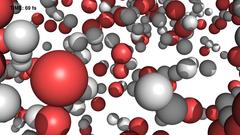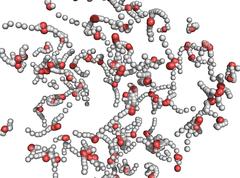URL: https://www.desy.de/news/news_search/index_eng.html
Breadcrumb Navigation
DESY News: World's fastest water heater - 100,000 degrees in 0.000 000 000 000 075 seconds
News
News from the DESY research centre
World's fastest water heater - 100,000 degrees in 0.000 000 000 000 075 seconds
Scientists have used a powerful X-ray laser to heat water from room temperature to 100,000 degrees Celsius in less than a tenth of a picosecond (millionth of a millionth of a second). The experimental set-up, that can be seen as the world's fastest water heater, produced an exotic state of water, from which researchers hope to learn more about the peculiar characteristics of Earth's most important liquid. The observations also have practical use for the probing biological and many other samples with X-ray lasers. The team of Carl Caleman from the Center for Free-Electron Laser Science (CFEL) at DESY and Uppsala University (Sweden) reports its findings in the journal Proceedings of the National Academy of Sciences (PNAS).

After about 70 femtoseconds (quadrillionths of a second) most water molecules have already split into hydrogen (white) and oxygen (red). Credit: Carl Caleman, DESY/Uppsala University
“Our heating is fundamentally different”, explained Caleman. “The energetic X-rays punch electrons out of the water molecules, thereby destroying the balance of electric charges. So, suddenly the atoms feel a strong repulsive force and start to move violently.” In less than 75 femtoseconds, that's 75 millionths of a billionth of a second or 0.000 000 000 000 075 seconds, the water goes through a phase transition from liquid to plasma. A plasma is a state of matter where the electrons have been removed from the atoms, leading to a sort of electrically charged gas.
“But while the water transforms from liquid to plasma, it still remains at the density of liquid water, as the atoms didn't have time to move significantly yet,” said co-author Olof Jönsson from Uppsala University. This exotic state of matter is nothing that can be found naturally on Earth. “It has similar characteristics as some plasmas in the sun and the gas giant Jupiter, but has a lower density. Meanwhile, it is hotter than Earth's core.”

Simulated paths of the atoms in the hot plasma. Credit: Carl Caleman, CFEL/DESY/Uppsala University
Apart from its fundamental significance, the study also has immediate practical significance. X-ray lasers are often used to investigate the atomic structure of tiny samples. “It is important for any experiment involving liquids at X-ray lasers,” said co-author Kenneth Beyerlein from CFEL. “In fact, any sample that you put into the X-ray beam will be destroyed in the way that we observed. If you analyse anything that is not a crystal, you have to consider this.” For crystals, other research has shown that a signal can be recorded before the crystal is destroyed.
The measurements show almost no structural changes in the water up to 25 femtoseconds after the X-ray pulse starts to hit it. But at 75 femtoseconds, changes are already evident. “The study gives us a better understanding of what we do to different samples,” explained co-author Nicusor Timneanu from Uppsala University, one of the key scientist developing the theoretical model used. “Its observations are also important to consider for the development of techniques to image single molecules or other tiny particles with X-ray lasers.”
Reference:
Ultrafast non-thermal heating of water initiated by an X-ray Free-Electron Laser; Kenneth R. Beyerlein, H. Olof Jönsson, Roberto Alonso-Mori , Andrew Aquila, Saša Bajt, Anton Barty, Richard Bean, Jason E. Koglin, Marc Messerschmidt, Davide Ragazzon, Dimosthenis Sokaras, Garth J. Williams, Stefan Hau-Riege, Sébastien Boutet, Henry N. Chapman, Nicusor Tîmneanu, and Carl Caleman; Proceedings of the National Academy of Sciences (PNAS), 2018; DOI: 10.1073/pnas.1711220115



